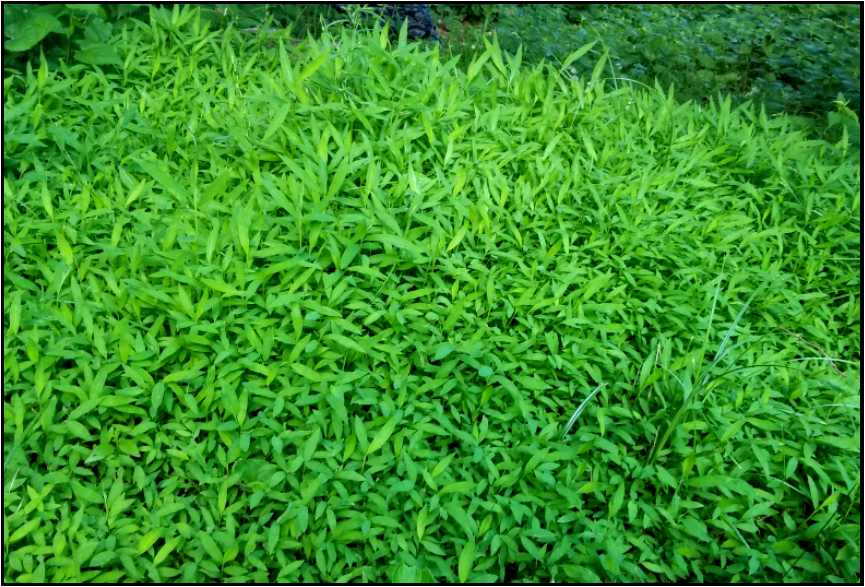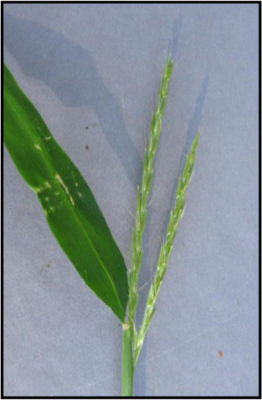Microstegium vimineum
By Victoria Wallace, Alyssa Siegel-Miles, and Klaudia Sowizral, UConn Extension
Identifying Features
- OVERVIEW: Annual grass. 1-3 ft in height. Arching, delicate habit. Similar in appearance to young bamboo.
- LEAVES: Alternate, lance-shaped, and 1-3 in long. Bright green. Upper blade sparsely hairy (silver hairs down the center). Sheath margin and collar hairy. Asymmetrical (off-center, shiny mid-rib). Broader and shorter than the leaves of most other annual grasses. Leaves are smooth when rubbed in both directions. Leaves become purple/reddish and pale yellow in late fall. Auricles absent.
- STEMS: Stoloniferous, which can increase the density of the infestation. Young stems may be reddish. After plants die back in late fall, dead, straw-colored stems persist through winter.
- FLOWERS: Flowers on 1- to 3-branched spikes formed at the top of each stem in late summer/early fall. Inflorescences can either require pollination or self-pollinate.
- ROOTS: Shallow, fibrous root system. Adventitious roots extend from the nodes, creating the appearance of “stilts” at the base of the plant.
- REPRODUCTION: Annual plant; reproduction by seed only (between 100 and 1,000 seeds per plant). Compared to crabgrass, seeds germinate earlier in early spring and mature later in fall (mid-Sept.-Oct.). Seeds remain viable in the seed bank for five or more years and spread through soil and water movement. Soil disturbance enhances germination.

Habitat
Japanese stiltgrass is most commonly found in flood-plains, stream banks, moist woodlands, and areas that are prone to soil disturbances, such as tilling, mowing, and deer traffic. It thrives in moist, acidic to neutral soils that are relatively high in nitrogen. While the plant readily invades shaded areas, it is also able to tolerate full sun and a low height of cut, enabling it to persist in a lawn environment.
Control
Early detection and control is critical to prevent severe infestations. As seeds are viable in the seed bank for five years or more, all control methods listed must be completed and monitored for multiple years. Reclaimed areas may be seeded with native or non-invasive nurse grasses. Contact your local extension specialist for recommendations.
MECHANICAL CONTROL:
- Hand-pulling may be feasible for small populations. The plant’s shallow root system makes it easy to pull. Plants can be left on site if they have not yet flowered. However, if the infestation includes flowering plants, they should be properly disposed of in garbage bags and disposed in municipal waste. If logistics permit, pulling after July (but before flowering) is preferred because, with earlier pulling, the soil disturbance may allow seeds in the seed bank time to germinate and establish.
- Mowing is an effective option to reduce seed production, either regularly at a low height of cut or once in late summer after plants have flowered, but before the seeds have set. Tilling may also be effective when done following the same precautions and timing as mowing.
- Flame weeding has been shown to be effective in moist sites where fire hazard can be mitigated.
- New York State Parks & Recreation has had success with several experimental methods, including covering stiltgrass infestations with 4-6 inches of mulch and seeding directly into the decomposing layer. Their experiments also indicate that using dry ice in late August can kill the plant, due to its lack of cold tolerance, and may prevent reinvasion for a few years while allowing native plants to re-emerge (nyis.info).
CHEMICAL CONTROL: Follow label direction when using all chemical treatments.
- While pre-emergent herbicides for grassy weed control can control the majority of germination, pre- and post-emergent herbicides are most effective when used in combination. Pre-emergents can be applied at intervals throughout the growing season to prevent germination, while post-emergents are applied when the plant is in full leaf, before seed set.
- When treating stiltgrass in wetland areas, ensure that an herbicide suitable for wetlands is used.
Distribution
Japanese stiltgrass currently has been recorded through-out much of the east coast, with a reported presence in 16 states. Populations of stiltgrass can be observed from New England south to Florida, and west to scattered counties in Texas.
Other Facts and Backgrounds
Japanese stiltgrass is native to Asia, including China, India, Japan, Korea, and Malaysia. It was introduced to Tennessee in 1919 as material used to package porcelain. Japanese stiltgrass is commonly mistaken for the native perennial Virginia cutgrass (Leersia virginica) or some of the Smartweeds (Persicaria spp.). Proper identification is crucial to effectively manage its spread.

SOURCES:
- Connecticut Invasive Plants Council. (2018, October). Connecticut Invasive Plant List. https://cipwg.uconn.edu
- National Park Service & U.S. Fish and Wildlife Service. (2010). Japanese Stiltgrass. In Plant Invaders of Mid-Atlantic Natural Areas, 4th ed. https://www.invasive.org/alien/pubs/midatlantic/mivi.htm#:~:text=Distribution%20and%20Habitat,gas%20and%20power%2Dline%20corridors.
- Neal, J. & Judge, C. A. (Updated 2023, June 21). Japanese Stiltgrass Identification and Management. NC State Extension. https://content.ces.ncsu.edu/japanese-stiltgrass-identification-and-management
- New York Invasive Species (IS) Information. (2019, July 2). Japanese Stiltgrass. Cornell Cooperative Extension & SeaGrant New York. https://nyis.info/invasive_species/japanese-stiltgrass/
- Pennsylvania Department of Conservation and Natural Resources. (n.d.). Invasive Plants in Pennsylvania: Japanese Stilt Grass.
Questions? Contact:
Vickie Wallace
UConn Extension
Extension Educator
Sustainable Turf and Landscape
Phone: (860) 885-2826
Email: victoria.wallace@uconn.edu
Web: ipm.uconn.edu/school
UConn Extension is committed to providing equal access and full participation for individuals with disabilities within all our programs and activities. Visit s.uconn.edu/accessibility for more resources. UConn is an equal opportunity program provider and employer.
Funds to support the creation of this document were provided by the Crop Protection and Pest Management Extension Implementation Program [grant no. 2017-70006-27201/project accession no. 1013777] from the USDA National Institute of Food and Agriculture.
©UConn Extension. All rights reserved.
Updated April 2021.
  |


